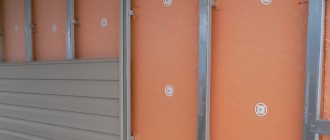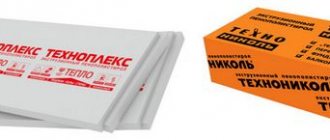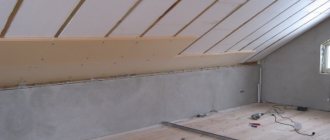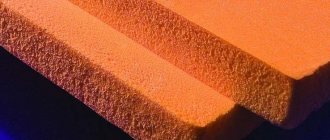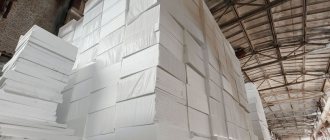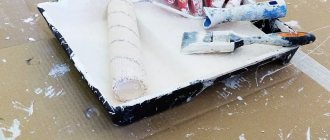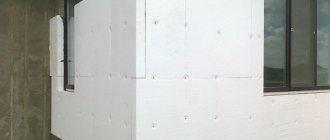Painting of foam plastic is carried out in order to protect the material from external influences (ultraviolet radiation, dust, dirt), increase the aesthetics of the finish and hide the joints between the slabs and elements. The main problem arises when choosing paint: not all compositions are compatible with the structure of polystyrene foam or have sufficient adhesion to its smooth surface. There are no specialized brands; most often, water-based or acrylic-based varieties are used, selected based on operating conditions. Maximum resistance to moisture is required for wet facades.
What paint can be used to paint polystyrene foam?
The main requirements put forward include:
- The absence of acetone, toluene, ethyl acetate and other organic solvents and ethers in the composition; any of these substances will corrode the foam and destroy its structure. For this reason, the material cannot be painted with alkyd paints.
- Good adhesion and elasticity. The cheapest and simplest oil paint, thinned with drying oil, is not suitable due to cracking after drying and peeling off from the foam.
- Resistance to precipitation for external surfaces, withstand wet cleaning for internal surfaces.
- Providing good protection of foam plastic from ultraviolet radiation and insolation (relevant for facades and areas near window openings).
- Sufficient coating density.
- Decorative effect, color preservation during operation.
The requirements are partially met by two types of paints: water-based and acrylic. The first variety is valued for its ease of application to foam plastic, vapor permeability and harmlessness, but due to its low resistance to moisture, it can only be painted on internal surfaces. Acrylic paints are more versatile, but their limitations include high price and fragility.
Which type is better to choose for interior work?
In this case, preference is given to affordable and harmless water-based brands; Snezhka, Dufa, Tikkurila, Caparol have the best reviews. They are applied in several layers (one is not enough, the structure will be visible) on the foam ceiling, wall panels and baseboards using a spray gun or brush and dry quickly without emitting an unpleasant odor. Water-based suspensions are quite attractive and do not fade.
To create a complex and multi-colored pattern, ordinary gouache is used; in this case, foam ceiling panels and decorative elements are decorated according to a template or painted individually. In this case, it is recommended to first paint the surface with one layer of water-based paint (to create a background and improve adhesion with the future pattern). Important nuances include the need to thoroughly dry each layer; foam itself does not absorb moisture, so the process takes a lot of time. Also, all joints and seams are covered with sealant.
It is recommended to paint areas exposed to intense moisture and contamination with expensive silicone compounds; they are better able to withstand frequent washing. Despite their high cost, they are chosen to protect foam panels or baseboards in bathrooms, kitchens and children's rooms. An alternative option is to cover it with acrylic paints: aerosols without freon from cans or regular brands. But it should be taken into account that such finishing needs frequent updating.
How and with what to paint polystyrene foam outside?
In this case, they stop at specialized brands for facades on a silicone or acrylic basis: Tikkurila, Terraco, Düfa. The finishing process becomes much more complicated if the foam is located outside; almost all weather-resistant paints in one way or another contain substances that destroy the structure. Simply painting it with moisture-resistant and safe acrylic is not enough: the seams and dowels will be visible, and the coating itself will not last long.
Painting a foam plastic facade is allowed only after sealing and finishing the joints with tape, applying a thin layer of plaster or treating the slabs with liquid glass. The minimum number of layers is 2.
Regardless of the location of the surface, polystyrene foam should be painted in conditions of normal or low humidity and at an air temperature of at least +15 °C. Preliminary cleaning of overly dirty areas with water is allowed, but finishing work begins only after they have completely dried. When painting foam plastic boards, it is advisable to choose a brand that does not require dilution; it is recommended to move it well using a construction mixer immediately before application. Any tinting or additives are administered in small doses.
When using a brush, it is necessary to paint polystyrene foam in one direction; for processing relief elements and large areas, it is better to choose a spray gun. The compositions are applied in thin, even layers (up to 2-3 times), each subsequent one after the previous one has completely dried. It is advisable to paint baguettes, complex decorative items and ceiling skirting boards made of foam plastic before installation, but in this case special attention is paid to the joints. When applying paint, it is recommended to hide wallpapered walls or other areas adjacent to polystyrene foam with masking tape. The last condition concerns time - the internal elements are updated at any convenient time, but the facades need to be painted before the start of winter.
Advantages of painted material
Polystyrene foam is a very popular material in construction; it is used for both external and internal work. However, after some time it may lose its attractive appearance. In addition, the initially white decor may not match the color scheme of the room. These reasons force craftsmen to paint materials in a shade suitable for the interior.
Due to the fact that some compounds can destroy the structure of polystyrene foam, before starting work it is important to figure out what paint to paint it with. Foam plastic will retain its attractive appearance for a long time if this work is done correctly. In this state it will have more advantages:
- it will be protected from moisture, dust, grease stains and other aggressive influences;
- polystyrene foam that turns yellow over time will not become noticeable under a layer of paint;
- painting will make everyday care easier;
- the decor will harmoniously fit into the design of the premises.
How to paint a concrete floor with polystyrene foam varnish - see in this video:
The material is very light and easy to work with, so it is used by professionals and home craftsmen. It is widely used not only in interior decoration of premises. Elements made of foam plastic often decorate the facades of buildings, gardening areas, and insulate the facades of buildings with slabs. With the use of coloring agents you can realize many original ideas.
A correctly chosen coloring composition can keep structures and decorative items beautiful and attractive for a long time. In this form, they will be less sensitive to sunlight and other destructive factors.
Advice from professionals
- After priming the walls, sand off any hardened stains. Otherwise, the paint will make the defects more noticeable.
- Treating the foam surface with putty, plaster or liquid glass allows you to use paint with any chemical composition. The protection is applied to a fiberglass mesh. The resulting covering layer relieves the PPS from aggressive coloring compounds and increases its resistance to destruction.
- To avoid getting a blueberry-colored jar instead of the desired forget-me-not shade, first mix a test batch of the color with paint. And then - the main part in adjusted proportions.
Painting foam plastic does not require years of experience, and the result will not lead to disappointment if you approach the matter thoroughly. Choose suitable compositions, maintain uniformity and do not rush to apply the next layers. Bright works to you!
Paint selection criteria
Foam products are sensitive to paints and varnishes. For this reason, you should carefully consider how to paint polystyrene foam so that it retains its appearance for a long time. Since this material does not tolerate acetone and other solvents, experts advise choosing water-based products. Such coatings are called water-dispersion. They can be:
Since foam does not tolerate solvents, the paint must be acrylic or water-based
- water-based;
- acrylic.
Any type of paint must meet basic requirements:
- it should fit well on the work surface;
- have high density and water resistance;
- be resistant to chemical influences.
All these parameters must correspond to the operating conditions of foam products.
However, not all foam items can be painted. The restriction applies, for example, to laminated plastic ceiling tiles. It just needs to be installed correctly, and it does not need painting.
Why plaster insulation?
Despite many advantages, insulation also has disadvantages:
- Subject to mechanical stress;
- Under the influence of sunlight it becomes deformed.
Therefore, this material itself needs to be protected from the effects of various environmental factors. And penoplex plaster is required. Most often, plaster is used for this. What mixture is suitable for plastering this insulation?
Let's try to figure it out.
Characteristics of coloring compositions
The range of coloring products is quite large. According to experts, it doesn’t matter what kind of paint you use to paint the foam, as long as it is water-based. This is due to the fact that the type of polymer almost does not reflect its properties. However, in order for the painting to be done efficiently, you should know the advantages and disadvantages of the compositions used.
The best paint option for polystyrene foam is acrylic.
Among the water-dispersed group of paints, acrylic paint has performed very well. This coating has the following positive properties:
- reliable protection against ultraviolet radiation;
- long service life;
- dries quickly and has no odor;
- health safety;
- ease of application;
- easy to clean if necessary;
- resistance to pollution;
- the composition is not affected by high temperature;
- a wide variety of shades.
Painted foam is easy to clean
In addition to the listed advantages, this coloring material has the only drawback - it is high cost. However, it is fully justified by significant advantages. A high-quality composition cannot be too cheap.
In addition to acrylic paints, you should pay attention to water-based coatings. They also have good properties. Among the advantages:
- environmental friendliness;
- lays down smoothly and has no odor;
- good vapor permeability;
- large color palette;
- average cost.
Surface preparation
Before proceeding to this stage, you need to make sure that the insulation is firmly attached. Preparatory work is carried out in the following sequence:
- penoplex is plastered. For this, a gentle acrylic base or a mineral/silicate mixture is used. This coating dries quickly and helps create a smooth surface;
- special attention is paid to areas around the seams and points where the dowel heads are located;
- the sheets are cleaned of dust and treated with a primer;
- after the primer solution has dried, the surface is leveled from drips using a spatula;
- then another, finishing, layer of plaster is applied;
- sand the surface.
Penoplex need not be plastered. However, in this case, applying high-quality coloring will be much more difficult. In addition, plaster creates an additional protective layer, without which penoplex is more susceptible to harmful environmental influences:
- under the influence of ultraviolet radiation and sunlight, it can become deformed;
- precipitation and temperature changes are destructive factors for this material.
Accordingly, in order to extend the service life of the insulation, it is better to immediately provide it with additional protection and paint the penoplex.
Three types of plaster are recommended as a solution for facing penoplex:
- mineral;
- silicate;
- acrylic.
The mineral mixture is produced on the basis of cement with the addition of polymer components. It is highly moisture resistant, resistant to mold and fungal infections. Thanks to its elastic structure, the composition is easy to apply and is an ideal option for protecting insulation.
Silicate plaster contains liquid glass, as a result the mixture has excellent adhesive ability: it sets very quickly on the surface of the penoplex. Moreover, it is not afraid of moisture and after drying it becomes very durable.
The acrylic composition for cladding insulation is ideal in cases where the surface is exposed to the active influence of the sun and precipitation.
Indoor work
The process of coloring foam products consists of several stages. Before you paint the foam, you need to prepare it. A primer is used for this. An aerosol composition is best suited for this purpose; it is simple and easy to apply to the desired object, the surface dries quickly and can be ready for subsequent work in a short time. This product is ideal for priming the desired element indoors.
Before you start painting parts, you need to prime them with an aerosol composition.
At the very beginning of work, you need to clean the surface with a damp cloth and wait until it is completely dry. When using an aerosol primer, it is recommended to shake the bottle for a few minutes before application and then coat the material with it.
The composition is sprayed quickly, applying a thin layer at a distance of 20 cm from the product. 3-5 layers of primer are enough to get a high-quality coating. After this, the material must dry completely. This takes approximately 30-30 minutes. Various irregularities or drips can be removed with a spatula, lightly touching the surface.
How and with what do you prime and paint polystyrene foam?
Rating 4.40 (10 Votes)
| Foam plastic is perhaps one of those types of materials that provides wide scope for creativity, allowing you to implement the most non-standard design solutions. Decorative products and structures, interior items, elements of building facades, garden sculptures - all this can be made from foam plastic. Today, architectural and decorative designers often use lightweight and durable foam plastic along with traditional materials such as plaster, marble, and stone. |
A creative approach and a couple of extraordinary ideas will help you create many original objects and designs from polystyrene foam. Sometimes simple shapes and a few color accents can be the icing on the cake in your interior design.
If we talk about decoration, since not every decorative material (primer, paint, varnish) will be compatible with a foam product, pertinent questions arise: How to process foam plastic? How and with what to paint it? Do I need to prime the foam and with what means? We tried to answer these questions and prepared some useful tips for you.
| What do you need to prime and paint foam board at home? - Soil. A special primer for polystyrene foam is ideal. - Dye. For decorative work, it is better to use aerosol paints for polystyrene foam or water-based acrylic paints packaged in jars and tubes, which do not contain solvents dangerous to foam plastic. - Varnish. Needed for additional surface coverage and protection of the material from external influences. It is important to use a universal water-based varnish. — Brushes, rollers and sponges for decoration |
— Paper tape (painting tape)
— Gloves, goggles/mask or painting kit
- Newspapers, film for covering surfaces, plastic sheet - any material that can protect the work surface during work.
— A container of water, cotton rags (cloths for cleaning), detergent.
— Acetone or white spirit for cleaning the work surface (NOT for foam products!)
.
| Materials for priming and painting foam products Before turning your creative ideas into reality, you need to carefully select materials and prepare the foam for work. An important step is the primer. An aerosol primer for foam plastic is very convenient; it is easy to apply, fits well on the surface, and dries quickly. This primer can be safely used for interior work. The choice of paint for foam plastic should be approached as responsibly as possible. Important to remember! Expanded polystyrene is absolutely not resistant to solvents. Therefore, avoid the following substances: acetone, white spirit in the composition, etc. Choose water-based paints. |
The ideal paint option is water-based aerosol. A wide palette of bright, saturated colors, the pigment of which is very durable. It is important that this paint is non-toxic, practically odorless, it is absolutely safe, so it can be used indoors. This paint is suitable for any surface, including foam.
| If your future product needs to be especially bright and expressive, choose fluorescent paint for graffiti. This is a durable, highly pigmented acrylic paint. The advantage of this paint is that it fits perfectly on a variety of surfaces, and is not at all dangerous for fragile foam plastic. Do you want to paint a product with a brush? Water-based acrylic paints in jars or tubes are perfect for this. The palette of such paints is rich in color shades that can be used not only for painting the surface, but also for applying designs. Working with acrylic paints is not difficult, but always check the instructions to take into account all the nuances. |
Step by step instructions
| Foam primer: Step 1 Clean the surface to be decorated with a damp cloth or sponge and wait until dry. Step 2 If you are using a spray foam primer, shake it well for about a minute. Spray with quick movements, holding the can vertically. Apply a thin layer at a distance of 20 cm from the surface. To achieve perfect coverage, it is advisable to apply 3-5 layers at intervals of 5-10 minutes. Paint all areas thoroughly and avoid the appearance of pores. The aerosol primer only needs 30-40 minutes until it dries completely, after which you can apply paint. |
IMPORTANT!!!
Laminated and extruded polystyrene foam requires special processing. First you need to sand the surface to make it rough. After this, the surface must be coated with a special adhesive primer (primer).
Step 3 If there are small streaks or dried drops left after the primer, just go over it lightly with a spatula to remove all the unevenness.
| Painting foam: Step 1 Prepare paint and all necessary tools. If you use aerosol paint to paint foam plastic, then before starting work you need to shake the can thoroughly for 1-2 minutes. You should hear a clear sound from the metal balls inside, then the paint is ready to go. Try to spray the paint evenly, the movements should be back and forth at a distance of 30 cm from the surface. Apply paint in 2-3 layers. Important! One coat takes at least 30 minutes to dry! After one layer has dried, you can safely apply the next one. This is perhaps the only difficulty; otherwise, working with aerosol paints is easy and convenient. |
Step 2 If you decide to paint the foam using a brush with acrylic paint from a jar or tube, then follow several rules. Mix the paint thoroughly before applying to the surface. To change the consistency or color of the paint, add water to it and mix well. The brush should be washed before each use of a new color.
Step 3 You can additionally seal the painted surface with varnish. Choose a specialized water-based varnish for this. You can safely use it to protect the surface of foam plastic painted with water-based acrylic paints.
| What should you pay attention to when painting foam? 1 To ensure that there are no streaks on the surface of the foam when painting, you must always move the brush in one direction. 2 If you suddenly purchased paint that contains solvents that are dangerous to foam plastic, then you can use a layer of ordinary plaster to protect the surface. This isolates the corrosive substances from the material. |
3 The paints and varnishes used must have a high adhesion coefficient (to Penoplex and PSB), it is good if the paints are resistant to atmospheric influences and odorless.
4 Coloring is best done at low humidity and an air temperature of at least 15 degrees.
5 If you work with paint from jars or tubes, it is useful to have a flat brush 4-5 mm wide in your arsenal. And for painting small details - a thin round brush.
6 Acrylic paints must be applied in a thin layer. If the layer is too thick, the coating will bubble when applied and will peel off after drying.
We tried to tell you about the most important points that you need to know when working with polystyrene foam. In fact, working with this material is not difficult, but you need to pay attention to the details. We wish you creative inspiration!
| Ideas: how to use polystyrene foam in decoration ♣ A foam panel will become a stylish addition to the interior. ♣ Children's room, advertiser's office, beauty studio, etc. can be decorated with bright, voluminous letters, large or small. It all depends only on your imagination. ♣ Figurines, New Year's toys, as well as small bright foam structures will become excellent decorative items during the holiday and beyond. |
Visitors to this page most often choose from the online store:
Aerosol primer for foam plastic 400 ml"
|
Sequence of actions during operation
To paint the outside and inside, select the desired type of composition. After choosing, you can start painting the product yourself. The easiest way to do this is to use a product in an aerosol package.
To paint polystyrene foam with your own hands, it is best to choose spray paint
Before starting work, shake the can for 1-2 minutes and then evenly cover the surface from a distance of 30 cm in 2-3 layers. Each time it must dry and only then can the next layer be applied. This method is considered the simplest if you learn how to work with a cylinder.
If the composition in a jar is used, painting is done using a brush or roller. The required amount of water is added to the paint to achieve a suitable consistency. If several tones are used, the composition should be mixed well before coating to obtain an even color. If the elements are painted in different colors, then the brush must be rinsed well with water each time.
To consolidate the result, you can use varnish. A special water-based varnish is often used in combination with acrylic paint to further protect the surface of the foam.
Step-by-step description of painting foam plastic
The procedure for painting polystyrene foam must include the following steps:
- Preparing the premises. The furniture is taken out of the room, and the remaining interior items are covered with film. After this, prepare a stepladder, brushes, a roller, and a bucket for the coloring composition.
- Surface preparation.
- Coloring polystyrene foam. To cover the surface evenly, you will need to apply several layers of paint. Before applying the next layer of composition, you need to wait until the previous one has dried.
Painting Tips
To ensure that painting the polystyrene foam surface was easy and high quality, experts advise you to listen to the recommendations:
- move the brush in one direction to prevent the formation of streaks and drips;
- To protect the wallpaper from contamination, use masking tape;
- To protect the surface from the harmful effects of gasoline or solvent, it is recommended to apply a layer of plaster.
After painting is completed, it is recommended to coat the surface with a special varnish. This substance will consolidate the result and preserve it for a long time.
Additional painting tips
To avoid leaving streaks on the foam, move the brush in one direction. The purchased material for painting must have a high adhesion coefficient. In this case, it will easily lie on the material.
To paint foam plastic, you need to have two brushes, wide and thin.
If the paint contains solvents that are hazardous to polystyrene foam, then a layer of plaster should be applied to the surface to be treated. It will serve as protection against destruction.
For better quality painting, it is better to have two brushes: a flat one 4-5 cm wide and a thin round one for processing small details.
When working outdoors, paint should not be used if the temperature drops below +15 o C. The quality of the coating will be negatively affected by high humidity. It is advisable to use only waterproof material.
Acrylic paint cannot be used in low temperatures and high humidity.
Acrylic compounds tend to bubble if they are applied in a thick layer. Over time it will begin to fall off. Experts recommend using paints that are completely ready for painting. They will make the work easier for those who do not have the necessary experience in this matter and will help to obtain a high-quality result.
The process of painting foam plastic has many subtleties and pitfalls. However, following these tips, a home craftsman will be able to carry out painting efficiently and quickly.
Selecting colorants for polystyrene foam is a particularly difficult task. After all, this type of material does not tolerate contact well with organic solvents, on the basis of which most paint and varnish compositions are created. If we take into account the characteristics of polystyrene foam and the composition of the materials that create the decorative coating, painting polystyrene foam occurs quickly and efficiently.
Plastering penoplex
Penoplex plaster has a certain technology. If these steps are performed correctly, we will get an excellent result. So, the order is:
- Preparing the solution
- Installation of reinforcing mesh;
- Grouting the surface;
- Padding;
- Surface leveling;
- Grout.
Preparing the mixture
The first stage of our work is preparing the mixture. The solution must be prepared following the instructions in the instructions. To process expanded polystyrene, craftsmen use both universal mixtures, which are used to glue segments of insulation to the wall and apply on top, and mixtures for narrow purposes.
Usually the manufacturer indicates the consumption on the packaging. But on average you can calculate it using the formula:
- When reinforcing, you need about 4 kg of mixture per 1 square meter;
- For leveling - 6 kg per 1 square meter.
These figures also depend on the thickness of the plaster layer: the thicker the layer, the greater the consumption.
Advice from the expert: To glue the reinforcing mesh, make the solution thinner than indicated on the package. And for leveling, the solution should have the consistency of jelly.
Installation of reinforcing mesh
The use of reinforcing mesh for penoplex plaster is a prerequisite for high-quality finishing of insulation. Otherwise, after drying, the solution will crack and fall off.
We begin to attach the reinforcement from the corners and slopes. To save on mounting corners, you can make such profiles from mesh with your own hands. We cut a strip about 35 cm wide and bend it in the center along the entire length. Next, apply the solution to the surface and apply our workpiece, slightly pressing it into the mixture.
And we do this with all angles. After this, glue the mesh over the entire remaining surface. At the same time, as if drowning our mesh in the solution. We glue the strips overlapping each other - about 5 cm.
We smooth the mesh from the center to the bottom, and from the center - up.
Popular paint and varnish compositions
The market offers a large selection of products that are widely used in exterior and interior work. But not every option is suitable for this purpose. Still, how to paint polystyrene foam? Let's look at each option in more detail:
- alkyd. To achieve optimal consistency, the paint is diluted with acetone, white spirit or solvent. Such components destroy the protective layer of polystyrene foam, making it unusable. Therefore, the option is categorically not recommended for use in this case;
- oil Drying oil is used in the production of paints. It does not have a negative effect on the surface of the panels, but its structure does not allow achieving the appropriate decorative effect. In this case, a “vitreous” coating is expected to appear. In addition, it has low strength;
- water-based. The products do not contain organic solvents. Therefore, water-based paint is considered the best option for creating a durable decorative coating. In addition, the acrylic pigments present in the composition have good adhesive properties. But when performing repair work, it is worth considering the type of material, since paint for external and internal work is produced separately.
Also suitable for this purpose is the use of acrylic aerosols that do not contain freon. If the finishing work is carried out correctly, the durability of such a coating is ensured. But unlike water-based paints, aerosols are more expensive.
Advantages of PVC skirting boards
First, let's look at the advantages of a plastic ceiling plinth.
Among its positive qualities are the following:
- Foam plastic does not collapse as a result of exposure to light, temperature and moisture, so the service life of the product is limited only by mechanical damage. By the way, the latter do not threaten the decorative element, because it is located high under the ceiling.
- The product does not absorb dirt and dust, so it is quite easy to clean. You can simply brush off the dust or wash with soap and water.
- The decorative element is made of safe material, so it is not harmful to health and is suitable for installation even in a child’s room.
- A large selection of shapes, sizes and textures allows you to choose the baseboard to suit the style of the room.
- Simplicity and speed of installation without a lot of debris and dust is an additional advantage.
- The product allows you to quickly cover unattractive joints between ceilings and walls, and hide small defects and cracks.
Stages of work
A step-by-step work diagram is presented using the example of painting the facade of a building. In this case, all existing nuances and aspects will be affected, since the facade is regularly exposed to ultraviolet rays, precipitation and temperature changes in spring and autumn.
After the panels are fixed to the outside of the walls, you can begin to work, namely, to create a high-quality base for paint. The following work steps must be completed:
- surface leveling. It is necessary to make the existing joints as invisible as possible, and also to level the areas where the dowels were located;
- cleaning It is necessary to remove accumulated dust and dirt from the surface. Otherwise, the adhesive properties of the soil composition will be lower than expected;
- primer. For this you can use a regular acrylic composition. The primer is poorly absorbed into the surface of the panels, so during the work, characteristic smudges may form, which will subsequently need to be removed with a spatula, otherwise, when creating a decorative coating, the paint will repeat the relief of all the formed drops.
Preliminary work allows you to create a durable and uniform surface without protrusions and gaps. Once all steps have been followed, you can begin painting. The process itself is quite easy. If you have the necessary tools, it can be performed by a person without the appropriate education.
Which is better: suspended ceiling or ceiling tiles?
The undoubted advantage of ceiling tiles is the ability to cope with the work without professionals. It is enough to buy the appropriate brand of glue and calculate the amount of material, and the gluing process will not be difficult. Also, the advantages include low cost. Perhaps this is all that can be said about the benefits of this material, now let’s talk about the disadvantages:
- Cannot be used in the kitchen: the surface is difficult to clean from the inevitable layer of soot and dirt.
- The products are flammable and do not comply with fire regulations. Expanded polystyrene is “famous” for its record-breaking short combustion period - less than 4 seconds.
- It cannot be installed in the bathroom, as the material has a low moisture protection threshold. If there is a leak from above, the adhesive may break down and peeling may occur.
- Installation requires a flat surface, only minor cracks are allowed.
- It should not be used in new buildings where the building is subsiding, leading to peeling of the ceiling covering elements.
- The glue does not erode for a long time, an unpleasant odor is felt, and air toxicity increases.
- It will not be possible to reliably hide communications, for example, electrical wiring.
- Even a slight increase in temperature is undesirable. Lighting fixtures get hot, so they need to be mounted as far as possible from the ceiling (minimum distance - 30 cm).
- The aesthetic appearance of the room suffers. The seams between the elements are noticeable and yellowness appears. Tile finishing does not fit into most interior solutions due to its excessive decorativeness.
Stretch ceilings, on the contrary, are distinguished by their aesthetics and ability to fit harmoniously into the interior. A smooth surface is provided, without the slightest defect. The widest choice of colors and the possibility of photo printing are attractive.
Installs within a few hours. Easy to clean: wipe with a soft cloth dampened with a small amount of detergent. It is environmentally friendly and not harmful to humans and animals.
Required Tools
To work you need to buy:
When painting a large area, it is appropriate to use a special device - a spray gun.
The material must be given the appropriate shade and poured into a pre-prepared bath. Using a roller, the decorative coating is applied to the wall surface. The tool must be operated correctly. The roller should move in one direction, namely, down-up. Such movements help minimize the appearance of streaks on the surface.
After the first layer has dried, you need to paint the walls again in the same color. Compliance with the stages of work involves creating a beautiful and uniform coating with a perfectly even tone.
Our company sells materials for thermal insulation. The catalog contains high-quality and highly technical products. Here you can choose materials for insulating buildings for different purposes.
Application
Finishing the surface with tiles allows you to quickly, inexpensively and effortlessly update the ceiling. It makes it possible to hide various defects without leveling or putty. The tiles are suitable for living rooms, bedrooms, offices and other rooms with acceptable air humidity.
Figure 2 Use in the kitchen.
This material should be used in kitchens and bathrooms with caution, as tiles in the kitchen quickly become stained and lose their original appearance, and in the bathroom they may become unusable due to high humidity. Only painting can prevent this from happening.
If you don't know whether ceiling tiles can be painted, pay attention to their color - if it's white, feel free to get to work
How to choose paint for polystyrene foam?
Exterior and interior finishing of buildings with polystyrene foam (expanded polystyrene) is becoming increasingly popular. However, the initially white color of the material does not always fit into the design. Therefore, the builder is faced with the question of how to paint the foam, taking into account its specific properties and structure? This article will help you understand the nuances of the process.
What paint is suitable?
When choosing paint, you should pay attention to:
1. its properties (good adhesion, moisture resistance, high density and resistance to chemical influences);
2. absence of solvent in the composition, since otherwise the latter will simply corrode the foam;
3. location of the surface to be painted (inside or outside).
Water-based paint is perfect for polystyrene foam. Its advantages include:
- harmlessness;
- no odor;
- good vapor permeability.
It is easy to apply and has a low cost, but has a low degree of water and dirt resistance. A more practical alternative would be to paint the foam with acrylic. Having the advantages of the previous option, this coating is also elastic, resistant to moisture, dust and temperature changes, and dries quickly. But it doesn't last long. Silicone mixtures are the leaders among solutions. They do not have the disadvantages of the above-mentioned paints. They can be chosen to paint the facade. At the same time, this composition is perfect for interior work, especially in rooms with high humidity.
How to paint interior foam surfaces?
It is better to treat elements of interior decoration made of polystyrene with water-based paint. This can be a baguette, tiles, foam baseboard. High quality paint does not create streaks or drops. It lies evenly on the product and closes the pores. Tikkurila Harmony, Sniezka Eco, Caparol Unilatex have received positive reviews here.
1. Before painting, the surface is thoroughly cleaned of dust using a dry cloth. You need to paint in one direction, avoiding streaks. The coating can be multi-layered. It is important to note that the surface must be completely dry before applying each subsequent layer.
2. If you need to paint foam ceiling panels, you should take into account some technological features. It would be useful to cover the furniture with polyethylene, use special glasses and work clothes. The tiles usually have a relief pattern. It is unlikely that you will be able to create an even coating with a roller and brush. Therefore, it is better to use a spray gun. And before that, all joints are puttied or sealant is applied. The entire required volume of paint of the desired shade is pre-prepared. The desired color is obtained using a tint, which can be selected in hardware stores.
3. When painting a foam ceiling plinth, it is easy to stain the wallpaper (if it is already glued). To avoid this, the obvious solution is to use thin brushes.
4. You can apply decorative elements using gouache. If desired, a product painted with water-based emulsion can be decorated with ornaments. First it is drawn with a pencil. And then gouache and brushes are used. This move will add originality to the interior.
Painting slabs outside the building
Expanded polystyrene is often used for cladding the external walls of buildings. Therefore, having dealt with the question of what paint can be used to paint polystyrene foam inside a building, you should decide on the materials used to decorate the facade. In this situation, it is preferable to choose an acrylic suspension. Moreover, it is better to purchase aerosols that do not contain freon. They dry instantly and create a waterproof film on the surface of the foam.
Although the choice of exterior paints is wide, most of them include aggressive components that destroy polystyrene foam. Therefore, before painting the foam boards lining the façade of the house, a protective layer must be applied to them. Most often, “liquid glass” is chosen for these purposes. It is pre-diluted with a primer, achieving the most uniform consistency. Another option for protecting foam is to apply liquid putty.
After drying, the facade can be painted with the selected acid-containing composition. The brush should be worked in one direction. It is recommended to apply at least two layers of paint, making sure to take a break before applying each subsequent one. Products that work well here are Novasil Tikkurila, Terraco Maxishield, Düfa Fassedenfarbe 90, acrylic aerosols Bosny and Pozitiv.
Is it difficult to paint polystyrene foam? Taking into account the nuances described in this article, the reader will cope with this process. Whether you need to paint the facade of the house or the foam ceiling, the result will definitely please you.
Dyeing technology
The process of giving the ceiling the desired color includes the following steps:
- Treatment of hard-to-reach places. The joints of the tiles with the baguette are painted with a narrow brush, forming a strip 5-10 cm wide. The tool is immersed in the coloring composition up to half the bristles and squeezed out, removing the excess.
- Distribution of paint over the surface. The layer is applied with a roller or brush in the direction of the light. The strips should touch each other's edges. The roller is moved from the corner to the center of the ceiling. To remove excess, the surface is treated with a semi-dry nozzle.
- Reapplication. The painted foam is dried for 6-12 hours. The water-based emulsion is reapplied. The stripes are applied perpendicular to the previous ones.
- Formation of the third layer. Start work from the corner opposite the window. The roller is moved parallel to the light beam. It is recommended to apply the last layer with a new nozzle. If it is missing, wash and dry the old one.
How to paint foam boards?
Painting of foam plastic is carried out in order to protect the material from external influences (ultraviolet radiation, dust, dirt), increase the aesthetics of the finish and hide the joints between the slabs and elements. The main problem arises when choosing paint: not all compositions are compatible with the structure of polystyrene foam or have sufficient adhesion to its smooth surface. There are no specialized brands; most often, water-based or acrylic-based varieties are used, selected based on operating conditions. Maximum resistance to moisture is required for wet facades.
What paint can be used to paint polystyrene foam?
The main requirements put forward include:
- The absence of acetone, toluene, ethyl acetate and other organic solvents and ethers in the composition; any of these substances will corrode the foam and destroy its structure. For this reason, the material cannot be painted with alkyd paints.
- Good adhesion and elasticity. The cheapest and simplest oil paint, thinned with drying oil, is not suitable due to cracking after drying and peeling off from the foam.
- Resistance to precipitation for external surfaces, withstand wet cleaning for internal surfaces.
- Providing good protection of foam plastic from ultraviolet radiation and insolation (relevant for facades and areas near window openings).
- Sufficient coating density.
- Decorative effect, color preservation during operation.
The requirements are partially met by two types of paints: water-based and acrylic. The first variety is valued for its ease of application to foam plastic, vapor permeability and harmlessness, but due to its low resistance to moisture, it can only be painted on internal surfaces. Acrylic paints are more versatile, but their limitations include high price and fragility.
Which type is better to choose for interior work?
In this case, preference is given to affordable and harmless water-based brands; Snezhka, Dufa, Tikkurila, Caparol have the best reviews. They are applied in several layers (one is not enough, the structure will be visible) on the foam ceiling, wall panels and baseboards using a spray gun or brush and dry quickly without emitting an unpleasant odor. Water-based suspensions are quite attractive and do not fade.
To create a complex and multi-colored pattern, ordinary gouache is used; in this case, foam ceiling panels and decorative elements are decorated according to a template or painted individually. In this case, it is recommended to first paint the surface with one layer of water-based paint (to create a background and improve adhesion with the future pattern). Important nuances include the need to thoroughly dry each layer; foam itself does not absorb moisture, so the process takes a lot of time. Also, all joints and seams are covered with sealant.
It is recommended to paint areas exposed to intense moisture and contamination with expensive silicone compounds; they are better able to withstand frequent washing. Despite their high cost, they are chosen to protect foam panels or baseboards in bathrooms, kitchens and children's rooms. An alternative option is to cover it with acrylic paints: aerosols without freon from cans or regular brands. But it should be taken into account that such finishing needs frequent updating.
How and with what to paint polystyrene foam outside?
In this case, they stop at specialized brands for facades on a silicone or acrylic basis: Tikkurila, Terraco, Düfa. The finishing process becomes much more complicated if the foam is located outside; almost all weather-resistant paints in one way or another contain substances that destroy the structure. Simply painting it with moisture-resistant and safe acrylic is not enough: the seams and dowels will be visible, and the coating itself will not last long.
Painting a foam plastic facade is allowed only after sealing and finishing the joints with tape, applying a thin layer of plaster or treating the slabs with liquid glass. The minimum number of layers is 2.
Regardless of the location of the surface, polystyrene foam should be painted in conditions of normal or low humidity and at an air temperature of at least +15 °C. Preliminary cleaning of overly dirty areas with water is allowed, but finishing work begins only after they have completely dried. When painting foam plastic boards, it is advisable to choose a brand that does not require dilution; it is recommended to move it well using a construction mixer immediately before application. Any tinting or additives are administered in small doses.
When using a brush, it is necessary to paint polystyrene foam in one direction; for processing relief elements and large areas, it is better to choose a spray gun. The compositions are applied in thin, even layers (up to 2-3 times), each subsequent one after the previous one has completely dried. It is advisable to paint baguettes, complex decorative items and ceiling skirting boards made of foam plastic before installation, but in this case special attention is paid to the joints. When applying paint, it is recommended to hide wallpapered walls or other areas adjacent to polystyrene foam with masking tape. The last condition concerns time - the internal elements are updated at any convenient time, but the facades need to be painted before the start of winter.


